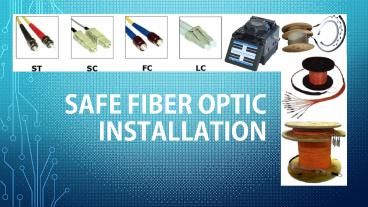Safe Fiber Optic Installation - PowerPoint PPT Presentation
Title:
Safe Fiber Optic Installation
Description:
Fiber optic systems transmit digital information using light -- visible or infra-red. The pulses of light are sent down cables made up of long glass-like filaments. Because light is involved and because these filaments are very friable, special precautions are necessary in fiber optic installation. Strong light sources can be hazardous to eyesight, while fragments of broken fiber optic cable can cause injury. – PowerPoint PPT presentation
Number of Views:204
Title: Safe Fiber Optic Installation
1
Safe Fiber Optic Installation
2
Personnel
- Fiber optic cables and installations should only
be handled by people who've been trained in
proper handling and safety precautions, and who
have access to the required safety clothing and
equipment. The general public should not be
allowed to enter an area where fiber optic
installation is in progress.
3
Light Hazards
- Although the light transmitted along fiber optic
cables is generally of a low intensity, looking
into the end of a cable can still be dangerous to
your eyesight. Testing equipment is available
that lets you know whether a fiber is "dark" (not
connected to a light source) before you look at
it. If visible light is in use, look at the fiber
from an angle, holding it at least six inches
away to see if light is present.
4
General Physical Hazards
- When cutting, splicing (joining) or terminating
(fitting terminals to) fiber optic cables, you
are continually exposing the bare ends of the
fibers and creating minute scraps of broken
fiber. These are small, brittle and very
difficult to see. The ends of these fiber scraps
are extremely sharp and can easily penetrate skin
or become lodged in your eyes.
5
Chemical Hazards
- The process of splicing and terminating fiber
optic cables can require the use of chemical
cleaners and adhesives. These need to be handled
carefully as they can include irritant and
flammable substances. Follow the manufacturer's
guidelines for handling each substance.
6
Source
http//www.ehow.com/info_8625006_safe-use-fiber-op
tic-cables.html
Images
http//www.desa.com.au/services/fibre-optic-cables































